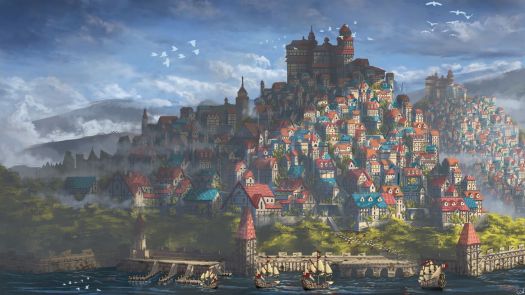Difference between revisions of "City"
Tao alexis (talk | contribs) |
Tao alexis (talk | contribs) |
||
| Line 1: | Line 1: | ||
[[File:City.jpg|right|525px|thumb]] | [[File:City.jpg|right|525px|thumb]] | ||
| − | The '''city''' is a | + | The '''city''' is a humanoid settlement, traditionally larger than 5,000 persons or 700 structures, with an economy primarily dependent on manufacturing, commerce and services. Though a city will be surrounded by fields and orchards — some of which may be inside the city's walls — it will depend upon importing enough [[Food|food]] to sustain its citizenry. To produce crafts and tools, materials are imported from near and far; after a fashion, the world is a city's hinterland. Every phase of life in the countryside contributes to the city's produce; |
Cities are the focal points of a region's power and culture; they are the seat of [[Temple|temples]], [[Market|markets]], the [[Town Hall|halls of justice]] and colleges. They arise out of the social need for defense; for contemplation and investigation of the world; as a connection with other places and cultures; and as financial and commercial authorities. Daily life within such places is ruled by matters of business; the need for work; and the constant struggle to dominate as much as possible the one finite resource: space. | Cities are the focal points of a region's power and culture; they are the seat of [[Temple|temples]], [[Market|markets]], the [[Town Hall|halls of justice]] and colleges. They arise out of the social need for defense; for contemplation and investigation of the world; as a connection with other places and cultures; and as financial and commercial authorities. Daily life within such places is ruled by matters of business; the need for work; and the constant struggle to dominate as much as possible the one finite resource: space. | ||
Revision as of 04:52, 16 October 2021
The city is a humanoid settlement, traditionally larger than 5,000 persons or 700 structures, with an economy primarily dependent on manufacturing, commerce and services. Though a city will be surrounded by fields and orchards — some of which may be inside the city's walls — it will depend upon importing enough food to sustain its citizenry. To produce crafts and tools, materials are imported from near and far; after a fashion, the world is a city's hinterland. Every phase of life in the countryside contributes to the city's produce;
Cities are the focal points of a region's power and culture; they are the seat of temples, markets, the halls of justice and colleges. They arise out of the social need for defense; for contemplation and investigation of the world; as a connection with other places and cultures; and as financial and commercial authorities. Daily life within such places is ruled by matters of business; the need for work; and the constant struggle to dominate as much as possible the one finite resource: space.
Settling Down
From earliest history, humanoids lived in self-sustaining groups and communities, without commerce with the outside. Settlements, when they formed at all, were tiny; fabricated out of materials readily at hand; and often seasonal in nature. With the development of agriculture and domesticed animals came the first villages. Where fertile soils and ample supplies of water coincided with practical routes and fords, villages became towns — larger centers for craftworkers and additional functions.
Markets for all sorts of produce sprang up and merchants engaged in long-distance trade. Moneylenders and scribes recorded the flow of goods and collected taxes. Princes and priests grew rich on the proceeds. Over time, the range of activities and sought-after resources increased; populations rose, swelling towns into cities. Some of these have survived for thousands of years, becoming celebrated as magnificent centers of art and spirituality.
But not all cities survive the trials of existence. Natural disasters, war, changes in climate or the presence of new, better cities cause the demise or destruction of a city. Occasionally, cities that are razed to the ground or denuded by plague revive and become restored — but others are abandoned altogether, even becoming "lost." The remains form ruins. Sometimes, their harbours filled with silt, the depletion of their resources or calamity, old cities revert to small towns or villages, their former glory all but forgotten.
Diversity
No two cities are entirely alike; what one lacks, another has in abundance. Climate, water supply, the persistence of volcanic activity or typhoons ... each brings their own hazards, though a city will continue to exist because of the purpose it serves, enabling it to flourish. Certain sites are much better suited to allow cities to thrive. For example, London is established at the narrowest, fordable part of the Thames, and was also the Roman route north. The main part of the city developed along the outside meander of the river, thus allowing easy access to fresh water. The advantages of favoured sites tend to possess certain characteristics.
- Mountain valleys provide protection where winds are strong and most of the land is steep and rugged. The river forming the valley brings good soil and fresh water, enabling agriculture and animal husbandry to thrive. And in mountainous regions, travel is necessarily confined to narrow routes ascending river valleys to mountain passes; control of an important route like this ensures a city's trade.
- Mountain sides are much rarer, but occur below important mountain passes where the valley is impassable or floods dangerously at times of the year. In the northern hemisphere, sites on south-facing slopes benefit from more sunshine, while in the southern hemisphere the reverse is true. More sun gives more warmth, allowing terraced cultivation.
- Hilltop cities are defensible and may have a symbolic significance. A prominent hilltop may become a religious center or pilgrimage site, with an associated settlement perched upon the hillsides below. In very rare cases, small cities may be located on mountain tops, thousands of feet above the valley floor, populated wholly by clerics or monks.
